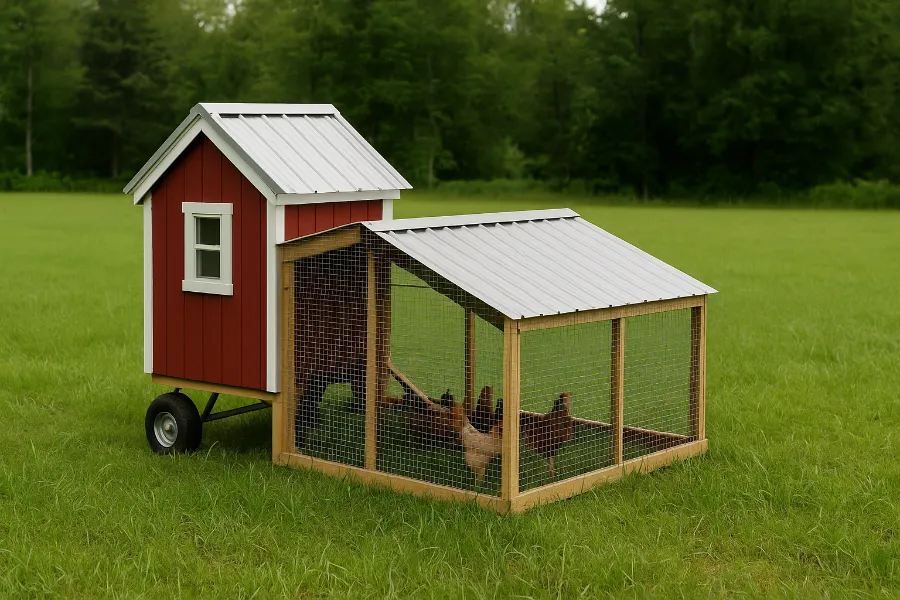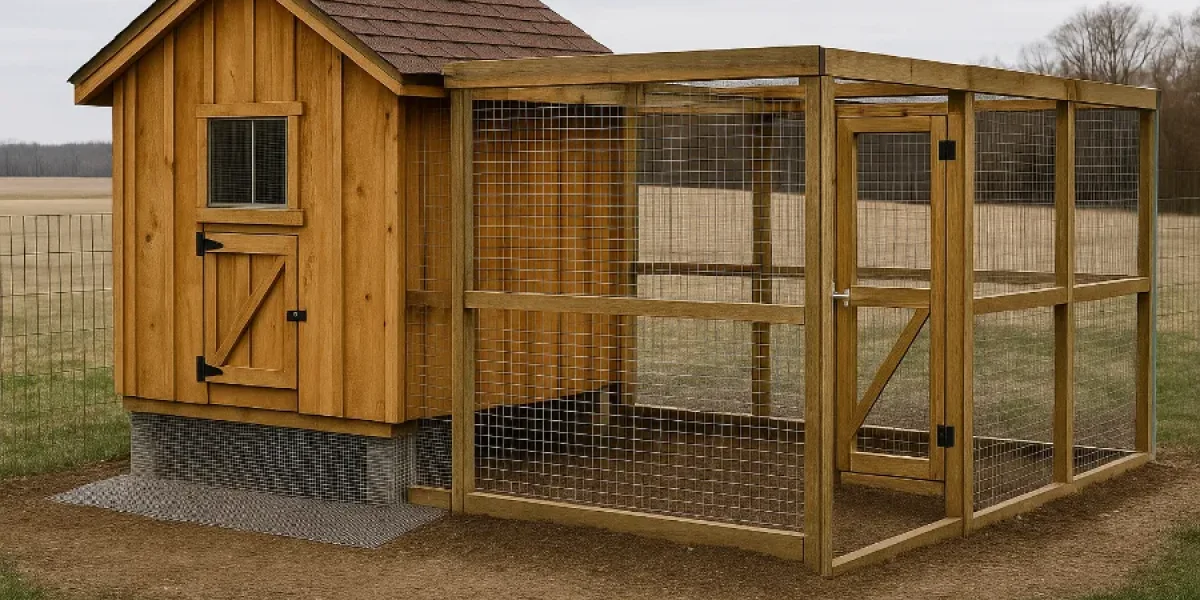When I built my first coop, I thought I’d done everything right. Solid wood, snug roof, even a lock on the door. But one morning, I walked out to find feathers where my favorite hen used to be. That was the day I learned the hard truth—a predator proof chicken coop isn’t just about wood and wire. It’s about outsmarting everything that wants what you have.
If you keep chickens long enough, you’ll cross paths with raccoons, foxes, snakes, hawks, and more. They’re clever, patient, and stronger than they look. Over time, I’ve learned exactly what works—and what doesn’t—to keep hens safe through the night. Here’s how I’ve built coops that not only look good but are truly predator proof, from the foundation up.
Predator Proof Chicken Coops

I’ve tried store-bought kits, DIY builds, and even an old shed turned chicken palace. Each version taught me something about what a predator proof chicken coop really means. It’s not just strength—it’s strategy.
Predators test your defenses every night. One will dig, another will climb, and some will patiently wait for your mistakes. The best coops protect on all sides: top, bottom, and every crack in between.
Here’s what I’ve found essential:
- Solid materials: Skip chicken wire and use hardware cloth instead.
- Secure locks: Raccoons can twist, pull, and pry anything that isn’t double-latched.
- Buried fencing: A hardware-cloth skirt buried 12 inches down keeps diggers out.
- Covered runs: Hawks and owls are silent hunters—don’t give them an open shot.
- Daily checkups: Walk your coop each evening before sunset. Look for fresh digging or loose nails.
A predator proof coop doesn’t happen overnight. It happens one improvement at a time—each upgrade a little more peace of mind.
Predator Resistant Chicken Coop
If “proof” sounds absolute, “resistant” is more realistic. The goal is to make your predator resistant chicken coop more trouble than it’s worth.
That’s how nature works—predators choose the easiest meal. If your coop takes effort, noise, and time to break into, they’ll move on.
Here’s how I build resistance in layers:
- Ground Defense: A hardware cloth apron around the coop base keeps diggers away.
- Wall Defense: Use ½-inch galvanized mesh for every opening. No gaps, no exceptions.
- Roof Defense: A solid metal or polycarbonate roof stops both climbing raccoons and diving hawks.
- Door Defense: Bolt locks, not hooks. Add carabiners for a raccoon-proof twist.
- Light and Motion: Solar lights or motion sensors give predators one more reason to back off.
A predator resistant chicken coop isn’t about fear—it’s about control. Once you’ve layered your defenses, you’ll sleep soundly knowing your hens are secure.

Chicken Coop Security
Good chicken coop security is more than structure—it’s routine. I treat mine like a nightly ritual.
Each evening, I lock doors, scan the run for holes, and check under the coop for digging. I’ve even caught a determined possum mid-sneak once. Consistency matters more than fancy gear.
Here are my golden rules for chicken coop security:
- Lock up before dark, not after.
- Keep feed sealed in metal bins (plastic just invites teeth).
- Never leave scraps or treats out overnight.
- Trim back brush so predators have nowhere to hide.
- Add cameras or trail lights if you live rural—it’s eye-opening to see what visits after midnight.
Predators are creatures of habit. When you become one too, you stay one step ahead.
Hardware Cloth for Chicken Coop
If there’s one thing I’ll never skimp on again, it’s hardware cloth for chicken coop protection. Forget chicken wire—it’s soft, flimsy, and meant to keep chickens in, not predators out.
Hardware cloth is welded steel mesh that can’t be chewed or pulled apart. I use it everywhere:
- Over windows and vents
- Beneath the coop floor
- Along the bottom edge of walls
- As the outer layer of the run
I recommend ½-inch galvanized hardware cloth. It’s small enough to block snakes and rats but allows airflow and light.
When I first upgraded my coop from chicken wire to hardware cloth, I noticed two things: fewer pests and quieter nights. No scratching, no chewing, no rustling—just calm.
Galvanized Steel Chicken Coop
If you want the ultimate in strength and longevity, a galvanized steel chicken coop is worth every penny. I switched to steel framing after years of patching wood rot and chasing termites.
Steel has no weak points. It won’t warp, chew, or crack. And if you live somewhere humid or rainy, galvanized metal means rust resistance too.
Here’s why I love it:
- Weatherproof: Handles storms, snow, and sun without splintering.
- Rodent-proof: Even determined rats can’t chew through steel.
- Easy to clean: A quick spray and it shines like new.
- Built to last: You’ll pass it down before it breaks down.
My current coop is a wood-steel hybrid—wood for charm, steel for safety. It’s the best of both worlds.
Raccoon Proof Chicken Coop
Let’s talk about the smartest troublemaker of them all: raccoons.
If you’ve never faced one, count yourself lucky. They can open locks, unscrew lids, and even pull wire loose. A raccoon proof chicken coop requires serious forethought.
Here’s what I do:
- Use two-step locks—a latch and a carabiner or padlock.
- Cover every opening with hardware cloth screwed down, not stapled.
- Add motion lights around the coop. Raccoons hate surprises.
- Keep doors flush—no gaps, no edges to grab.
- Never leave eggs or food overnight; it’s like setting the table for thieves.
One raccoon attack is all it takes to change how you build forever. They’re clever, but you can outsmart them.
Fox Proof Chicken Coop
Foxes are my countryside nemesis. Fast, quiet, and relentless. To make a fox proof chicken coop, you’ve got to think underground.
Foxes dig. And when they can’t dig, they test your gates and corners.
I stopped them by:
- Installing an 18-inch predator apron made from hardware cloth buried outward.
- Reinforcing doors with heavy hinges and bolts.
- Using tall fencing (at least 6 feet) around the run.
- Covering the run roof—foxes can climb if they’re desperate.
If you’re rural, consider a low-voltage electric wire around your perimeter. It’s harmless but sends a clear message: this buffet is closed.
Snake Proof Chicken Coop
Snakes are stealthy guests—no noise, no warning, just missing eggs. A snake proof chicken coop relies on detail work.
Here’s what’s worked for me:
- Seal every crack wider than a pencil with caulk or flashing.
- Replace vent covers with ¼-inch hardware cloth.
- Keep the coop floor tight and sealed.
- Raise the coop off the ground on cinder blocks or stilts.
- Clear brush and clutter; snakes like cool hiding spots.
When I started doing this, my egg losses dropped to zero. Snakes go where rodents go—so keep your coop clean and your feed sealed.

Hardware Cloth vs Chicken Wire
This debate comes up constantly—hardware cloth vs chicken wire. Let me make it simple:
Chicken wire is for gardens. Hardware cloth is for predators.
| Feature | Hardware Cloth | Chicken Wire |
|---|---|---|
| Strength | Welded steel | Twisted thin wire |
| Hole size | ¼–½ inch | 1–2 inches |
| Stops predators | Yes | No |
| Durability | Years | Months |
Chicken wire will stop your hens from wandering, but it won’t stop a raccoon’s claws or a fox’s teeth. The day I swapped every inch of chicken wire for hardware cloth was the day my flock finally slept safely.
Backyard Chicken Coop Ideas
Just because a coop is secure doesn’t mean it can’t be beautiful. I’ve seen stunning backyard chicken coop ideas that combine safety with style.
Some of my favorites:
- Greenhouse Coops: Warm in winter, ventilated in summer.
- Rustic Wood + Metal: A balance of charm and durability.
- Walk-In Runs: Easier to clean, safer for you and the birds.
- Mobile Chicken Tractors: Keeps predators confused and grass fresh.
- Upcycled Sheds: Reinforced with hardware cloth and new paint—cheap and charming.
You can have personality and protection. A secure coop doesn’t have to look like Fort Knox; it just has to act like it.
Chicken Coop for Small Backyard
Even a chicken coop for small backyard setups can be predator proof—you just have to use space wisely.
When I lived on a small lot, I learned a few tricks:
- Go vertical. Stack nesting boxes and roosts to save ground space.
- Attach a run directly to the coop for instant access and protection.
- Use raised coops to create shade and prevent burrowers.
- Add automatic doors so you don’t rush home at sunset.
- Keep it near the house. Predators are shy of human activity.
My small-space coop ended up being one of my safest. Sometimes a smaller footprint means fewer weak spots.
Final Thoughts: Building a Predator Proof Chicken Coop That Lasts

Building a predator proof chicken coop isn’t about paranoia—it’s about peace of mind. I’ve rebuilt, reinforced, and redesigned more times than I can count, but each version gets closer to perfect.
The secret isn’t fancy gear—it’s commitment. A secure coop is built through attention, habit, and the willingness to learn from every close call.
So whether you’re starting with a steel frame, a reclaimed shed, or a humble wood box, remember this:
Every latch tightened, every gap sealed, and every fence buried is a promise that your flock will see another sunrise.
And that’s what real chicken keeping is all about.
FAQs
A predator proof chicken coop uses stronger materials like hardware cloth, secure locks, and buried fencing to block digging and climbing predators. It’s built to resist raccoons, foxes, snakes, and other threats day and night.
Yes, you can repurpose sheds or wooden structures and reinforce them with hardware cloth and solid locks. Even simple upgrades like a buried wire skirt and motion lights can make a big difference.
Absolutely. Hardware cloth is welded steel mesh that resists chewing and tearing, while chicken wire is flimsy and only keeps chickens in—not predators out.
Install a predator apron made of hardware cloth buried 12–18 inches deep or bent outward around the coop’s base. Adding gravel or bricks along the edge helps discourage digging.
Use double latches or padlocks since raccoons can open simple hooks. Cover all vents and windows with hardware cloth and remove food overnight to reduce attraction.
Seal every crack wider than half an inch, raise the coop off the ground, and cover all vents with fine hardware cloth. Keeping the area clean and rodent-free also deters snakes.
Galvanized steel or reinforced wood with hardware cloth offers the best protection. Steel is chew-proof, weather-resistant, and ideal for both small and large backyard setups.













